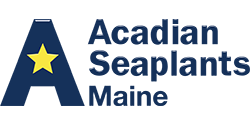You say you harvest 17% of the total biomass, what does that mean exactly?
We determine the amount of biomass in each area that we harvest through a combination of satellite imagery and scientific ground truthing techniques. GIS software makes it possible for us to use satellite images to calculate the area of Ascophyllum within each sector. We then visit the beds within each sector to determine the biomass that can be harvested. Some beds cannot be harvested because of gear limitation, safety or economic reasons and they are excluded from our calculations. Using the area and the measured biomass, we then calculate the total harvestable biomass within each sector and annually, we harvest up to 17% of that biomass. It has been estimated that there is 1,000,000 MT of Ascophyllum in Maine and the industry will never harvest beyond 5% of that biomass annually.
Does harvesting affect the reproduction of Ascophyllum?
Ascophyllum nodosum typically starts forming reproductive receptacles in the summer and they grow throughout the winter and early spring. Receptacles are shed and gametes are released between mid-May and early June. The bulk of our harvesting occurs from late May through mid-October, after gametes have been released. Obviously, fronds that have been harvested cannot produce reproductive structures, but the current harvest in Maine affects only 1-2% of the reproductive biomass, leaving 98-99% of the reproductive potential untouched.
What about bycatch? How do you protect against bycatch and holdfast removal?
Bycatch: The most common bycatch are periwinkles and the impact of the harvest on this species has been calculated by DFO in Canada and by the University of Maine in a study in Cobscook Bay in 2009. The impact in Cobscook Bay was calculated to be around 0.04% of the snail population being taken as bycatch by the harvest from the rockweed covered areas. We know that snails are also found in the unvegetated intertidal area, thus the overall impact is even lower. For the entire state, we can estimate that 24,250 pounds of periwinkle are harvested as bycatch yearly. In comparison, 727,866 pounds of periwinkle were commercially harvested in 2017.
Holdfast: Holdfast incidence in the harvested material can be the result of brittle substrates holding the rockweed clumps, a naturally damaged clump or the condition of the harvesting tool. The 7.78 % holdfast incidence registered for Cobscook Bay in 2009 was slightly higher than the incidence found in the harvest in Canada (6.6%). In most cases, only a small portion of holdfast was removed, leaving enough for each individual to survive.
The impact of the harvest can be compared to those of natural events as follow; the total rockweed biomass for Cobscook Bay is around 50,000 tons (conservative estimation made by Acadian Seaplants) and from growth and production data for this seaweed in the region (Vadas et al. 2004), a minimum of approximately 20,000 tons of biomass is released as storm-cast material each year. Average holdfast incidence in storm cast material has been evaluated around 27% along the Bay of Fundy. Thus, a minimum of 5,400 tons of biomass bearing holdfasts are naturally detached each year in Cobscook Bay, an impact 63 times greater than the harvest.
Would Acadian ever invest in a processing facility in Maine?
Regardless of the outcome of the lawsuit, Acadian Seaplants intends to continue investing in Maine. It’s impossible to say right now whether that means investing in some sort of processing facility in the future.
How much do you invest in Maine?
We have five full-time employees (a director, a resource science technician and three resource managers) between 25-30 seasonal harvesters and two mechanical harvester operators. We do all our maintenance work locally on the outboards at Whitney’s in Machias, all our mechanical harvester work at Billings in Stonington. In total, we invest about $700,000 in Maine annually. Acadian Seaplants has been operating a commercial harvest in Maine since 2000 and continues to make the investments necessary to conduct a sustainable rockweed harvest.
What was the lawsuit about?
In Maine, unlike virtually every other state in the country, most landowners own down to the low tide mark. There is an exemption for “fishing, fowling and navigating” within the intertidal zone (the area between low and high tide). This exemption is what allows those who ply their living in the intertidal zone – marine worm diggers, clammers, Rockweed harvesters – to work in the intertidal zone.
The plaintiffs in the lawsuit clamed that Rockweed harvesting was not ‘fishing’ and therefor not allowed within the general exemption of fishing, fowling and navigating (this of course begs the question of whether marine worms are a “fish” – an adverse outcome in this lawsuit will likely create a slippery slope with respect to others who make their living in the intertidal zone).
The legal question being considered is narrow, but the implications are considerable for Maine’s economy and its working waterfront. Given that shorefront property in Maine is increasingly owned by out-of-state landowners, a finding for plaintiff/landowners would have the very unfortunate effect of putting access to an important economic marine resource in the hands of out of state residents.
You’ve always been a supporter of the hand harvesting method, why are you switching to mechanical harvesting?
We’re not switching to mechanical harvesters. We’ve diversified our harvesting practices with two mechanical harvesters in Maine to see how they work, and get a feel for mechanical harvesting in general. It is becoming increasingly difficult to find local people interested in hand harvesting so adding mechanical harvesters is one way to address our changing workforce. It also affords an opportunity to provide year-round employment. At this time, we’re not certain whether we’ll add more mechanical harvesters or not, but if we do, we anticipate building them here in Maine. We’re actively studying the best way to sustainably manage the resource with mechanical harvesters.
